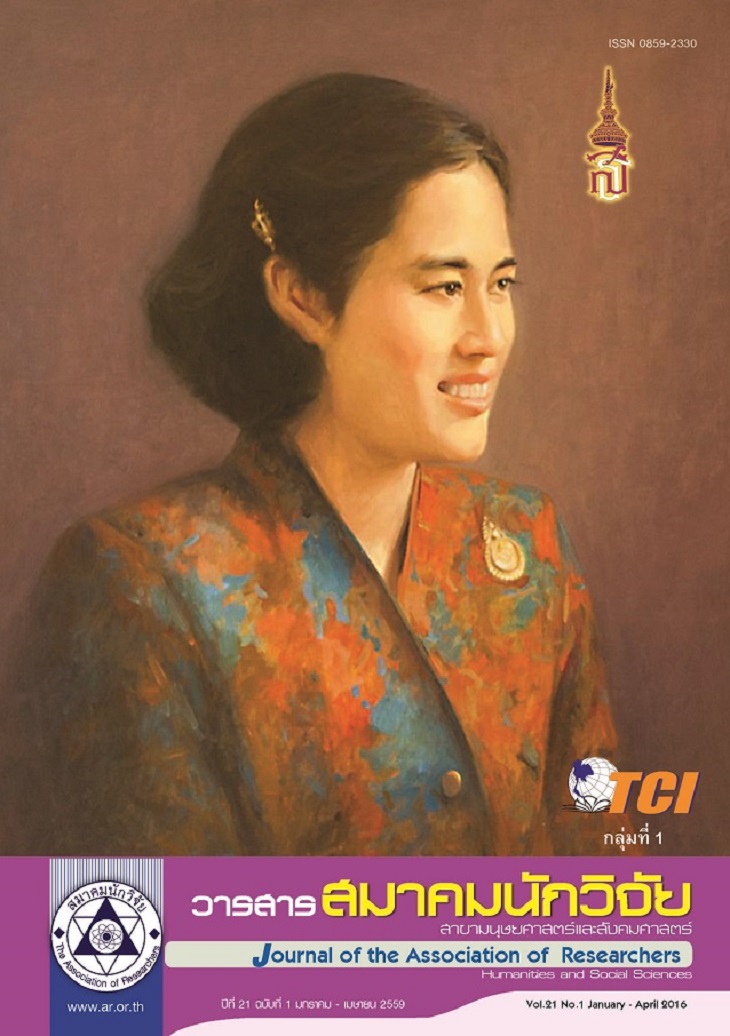Development of A Model of Public Organizational Effectiveness Measurement in ASEAN: Multilevel Structural Equation Model Analysis
Main Article Content
Abstract
The objectives of this research were: (1) to develop public organizational for educational institutions effectiveness measurement model in ASEAN (2) to study causal factors from ASEAN influencing public organizational for educational institutions effectiveness at individual and academic field levels and (3) to test invariance of a multilevel causal analysis model of educational institutions effectiveness between Thailand Lao People’s Democratic Republic and Kingdom of Cambodia. A total of 120 fields and 1,200 samples were randomly stratified. Instrument used was a questionnaire of organizational effectiveness of Cameron (1978, 1986) was described by 9 variables. The results with reliability Cronbach’ s alpha coefficient ranging from 0.718 to 0.898. Statistical analyses were made
based on descriptive statistics and Multilevel Structural Equation Model analysis were performed using Mplus. The research results were shown as follows: (1) The model of public organizational for educational institutions effectiveness in ASEAN in terms of student s’ perceptions indicated that for both levels, all variables were important for representing the effectiveness. At the individual level, the most important variable was the student personality development while, at the field level, the most important variable was the staff employment satisfaction. However, the organizational health was less important at both levels. (2) The proposed multilevel causal model of public organizational for educational institutions effectiveness in ASEAN fitted quite well with the empirical data. The predictor variables at the individual and field levels accounted for variance of public organizational effectiveness in ASEAN about 76.90% and 77.90%, respectively and (3) Multilevel Structural Equation Model the organizational effectiveness of the public sector for educational institutions in the region has variance the model between Thailand Lao People’s Democratic Republic and Kingdom of Cambodia. The recommendations for future research should include Multilevel Structural Equation Model to study the effectiveness of the public sector in each country separately and adding qualitative information to find
ways to develop further
Article Details
บทความที่ปรากฏในวารสารนี้ เป็นความรับผิดชอบของผู้เขียน ซึ่งสมาคมนักวิจัยไม่จำเป็นต้องเห็นด้วยเสมอไป การนำเสนอผลงานวิจัยและบทความในวารสารนี้ไปเผยแพร่สามารถกระทำได้ โดยระบุแหล่งอ้างอิงจาก "วารสารสมาคมนักวิจัย"
References
ภัทราวดี มากมี. (2553). การพัฒนารูปแบบการวัดประสิทธิผลองค์การสำหรับคณะครุศาสตร์/ศึกษาศาสตร์ : การประยุกต์ใช้การวิเคราะห์เชิงสาเหตุพหุระดับ. วารสารวิธีวิทยาการวิจัย (Journal of Research Methodology),23(1), 55 - 75.
รัชกร โชติประดิษฐ์ และคณะ. (2558). โมเดลความสัมพันธ์เชิงสาเหตุของส่วนผสมทางการตลาดสำหรับธุรกิจบริการที่ส่งผลต่อพฤติกรรมทางการตลาดของนักท่องเที่ยวในการเลือกเข้าพักที่โรงแรม จังหวัดอุบลราชธานี ประเทศไทย. วารสารสมาคมนักวิจัย (Journal of the Association of Researchers), 20(2), 94 - 104.
ศิริชัย กาญจนวาสี. (2550). ทฤษฎีการทดสอบแบบดั้งเดิม. พิมพ์ครั้งที่ 6. กรุงเทพฯ: โรงพิมพ์แห่งจุฬาลงกรณ์มหาวิทยาลัย.
ศิริชัย กาญจนวาสี. (2554). การวิเคราะห์พหุระดับ. พิมพ์ครั้งที่ 5. กรุงเทพฯ: โรงพิมพ์แห่งจุฬาลงกรณ์มหาวิทยาลัย.
สำนักงานคณะกรรมการการอุดมศึกษา. (2551). ข้อมูลสารสนเทศอุดมศึกษาเชิงสถิติ[ออนไลน์]. แหล่งที่มา: http://www.mua.go.th/student.php[15 ม.ค. 2557]
สำนักงานรับรองมาตรฐานและประเมินคุณภาพการศึกษา(องค์การมหาชน). (2547). พระราชบัญญัติการศึกษาแห่งชาติพ.ศ. 2542 แก้ไขเพิ่มเติม (ฉบับที่ 2) พ.ศ. 2545. กรุงเทพฯ. พริกหวานกราฟฟิค.
สุชาติ เอกปัชชา สุทธนู ศรีไสย์ และจินต์ วิภาตะกลัศ. (2557). ประสิทธิผลการบริหารจัดการโรงเรียนดีประจำตำบลในประเทศไทย. วารสารสมาคมนักวิจัย (Journal of the Association of Researchers), 19(1), 47-58.
สุภัทรา วีระวุฒิ. (2554). ปัจจัยที่มีอิทธิพลต่อประสิทธิผลของโรงเรียนประถมศึกษา สังกัดสำนักงานคณะกรรมการการศึกษาขั้นพื้นฐานในจังหวัดนนทบุรี. วารสารการบริหารและพัฒนา, 3(3), 111-126.
อุบล ทัศนโกวิท และคณะ. (2558). องค์ประกอบที่สัมพันธ์กับประสิทธิผลการจัดการเรียนรู้ตลอดชีวิตของศูนย์การศึกษานอกระบบและการศึกษาตามอัธยาศัยอำเภอผ่านการรับรู้ของครู. วารสารสมาคมนักวิจัย (Journal of theAssociation of Researchers), 20(1), 146-157.
Cameron, K. S. (1978). Measuring organizational-effectiveness in institutions of higher-education. Administrative Science Quarterly, 23: 604-632.
Cameron, K.S. (1986). A study of organizational effectiveness and its predictors. Management Science,32: 87-112.
George, D., and Mallery, P. (2003). SPSS for Windows step by step: A simple guide and refernce. 4th ed.Boston: Allyn & Bacon.
Gibson, J. L., Ivancevich, J. M., and Donnelly, J. H. (2000). Organizations: Behavior, Structure, Processes.10th ed. Boston: McGraw-Hill.
Goodman, P. S., and Pennings, J. M. (1980). Critical Issues in Assessing Organizational Effectiveness.In Lanler, E.E., and Seashore, S. E. (eds.), Organizational Assessment Perspective on the Measurement of Organizational Behavior and the Quality of Work Life. New York: John Wiley & Son.
Harrison, M. I. (1994). Diagnosing Organizations Methods, Models and Process. London: Sage Publications.
Hox, J. J., and Maas, C. J. M. (2001). The accuracy of multilevel structural equation modeling with pseudobalanced groups and small samples. Structural Equation Modeling, 8: 157-174.
Katz, D., and Kahn, R.L. (1978). The Social Psychology of Organizations. 2nd ed. New York: John Wiley &Son.
Muthén, L. K., and Muthén, B.O. (2012). Mplus: The Comprehensive Modeling Program for AppliedResearchers user’ s guide, Version 7.00. Los Angeles, CA: Muthén & Muthén.
Price, J. L., and Mueller, C. W. (1986). Handbook of Organizational Measurement. Massachusetts: Pitman.
Schumacker, R. E., and Lomax, R. G. (2004). A beginner’s guide to structural equation modeling.Lawrence Erlbaum.
Steers, R. M. (1977). The Organizational effectiveness : a behavioural View . Goodyear Publishing,Santa Monica. California.
Stufflebeam, D. L., et al. (1971). Educational Evaluation and Decision Making. Bloomington: Phi Delta Kappa.


